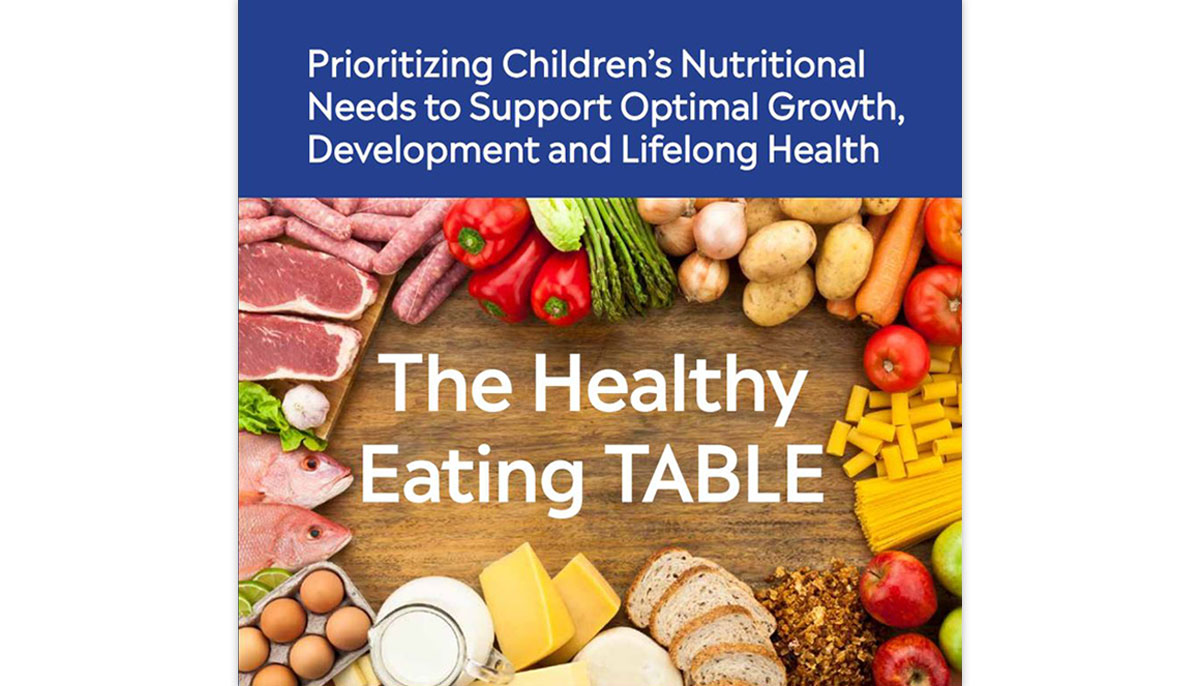Translating, Amplifying + Bridging the Latest Evidence in Nutrition and Dairy Science

By: Kristal Shelden, MPH, RDN and Ashley Rosales, RDN

Efforts to support optimal health for children should address nutritional needs for proper growth and development, as well as prevention of obesity and other chronic diseases, while setting a strong foundation for learning and lifelong success. With a growing number of priorities critical to overall child health, nutritional needs can be easily overlooked, posing risk for inadequate consumption of nutrient-dense foods during childhood and beyond. Consideration for the nutritional needs of pregnant women, infants and children, which differ from the population as a whole, is essential for solutions that support healthy, sustainable eating patterns while meeting nutrient needs of children during critical growth windows.
After decades of increases, the national childhood obesity rate has held relatively stable in recent years. Yet childhood obesity rates remain historically high, putting millions of young people at greater risk for serious health conditions, including high blood pressure, type 2 diabetes, heart disease and asthma.
Obesity rates rise with age and there are significant inequities in rates, particularly for black and Hispanic youth. According to the Robert Wood Johnson Foundation (RWJF) State of Childhood Obesity report released in October 2019, the United States spends $14 billion annually on childhood obesity alone.1 The report aims to shed light on the complexity underlying the causes of obesity, ranging from economic, policy and environmental influences to cultural norms and individual factors. Solutions to address the interrelated issues of food insecurity, nutritional inadequacy and childhood obesity are equally complex. These interrelated issues continues to disproportionately affect communities of color and low-income families.
Food insecurity and economic inequality are growing and being more deeply felt by vulnerable communities. This is reflected by a recent report from the US Department of Agriculture’s Economic Research Service, which found that the number of households experiencing food insecurity remains high despite recent improvements.
The report found that even though household food insecurity rates in the United States have declined over the past several years to the pre-recession (2007) level of 11.1%, more than 14 million households are still struggling to put food on the table. Furthermore, rates are disproportionately higher for households with children, particularly those headed by a single adult, households in urban areas, and black- and Hispanic-headed households. The problems facing these communities go beyond food access and can include water access, economic opportunities and access to health care. Combined, these issues contribute to increased levels of obesity and chronic diseases and negatively impact the growth and development of children in these vulnerable populations.2 Food insecurity remains a major issue in the United States, and much progress still needs to be made.3
Although elevating the health of children requires a multitude of strategies, focus should be given to specific areas that have potential to make significant improvements.
Scientific research confirms that milk, yogurt and cheese offer a unique package of nutrients—calcium, vitamin D, potassium and more—that work together to provide multiple health benefits, including optimal growth and development in children and reduced risk of developing chronic diseases such as type 2 diabetes and heart disease.4 The wide variety of milk and dairy foods available provides many options to meet personal needs, tastes and preferences.

Dairy foods offer health attributes that are different from plant-based and other animal-source foods due to dairy’s complex mix of nutrients, bioactives and other components. For example, when compared with plant-based beverages, dairy milk has the most balanced distribution of energy from carbohydrates, protein and fat, coupled with a unique nutrient package that can be difficult to replace in a healthy dietary pattern. This is especially true for young children and adolescents, with dairy foods making an important dietary contribution that supports their optimal growth and development.
In addition to emphasizing the consumption of a variety of plant-based foods, the Dietary Guidelines for Americans recommends consuming dairy to meet nutritional needs and reduce the risk for chronic diseases. Data show that most Americans are not meeting the consumption recommendations for vegetables, fruits and dairy,5 which all provide important nutrients that support optimal health and academic success. Encouraging consumption of nutrient-dense foods, from both plant-based and dairy sources, can help close the nutrient gaps that exist among Americans of all ages.

Research shows that what children drink can have a big impact on their health, as beverages make a significant contribution to dietary intake. However, with so many choices available in the marketplace and misinformation abounding, it can be confusing for parents, caregivers and even health educators to know which beverages are healthy and which ones to avoid. An analysis of the sales, nutrition and marketing of children’s beverages in the United States found that sweetened drinks represented nearly two-thirds of children’s drink sales in 2018.6 These drinks targeted to children often contain misleading health messages and are disproportionately advertised to black and Hispanic children. Attempts have been made by many authoritative bodies to provide guidance and recommendations for healthy beverage intake, but important gaps still exist.
Nationally representative data confirm that beverage consumption patterns of young children diverge from current recommendations. Among children ages 2 to 5 years old, 44% consume sugar-sweetened beverages, with an average daily intake of 9 ounces. Overall, beverages contribute 32% of added sugars in children’s diets.7 Furthermore, significant disparities exist across ethnic groups and income levels. For instance, non-Hispanic blacks consume more sugar-sweetened beverages and fruit-flavored drinks than non-Hispanic white and Hispanic children.8 Among 0- to 2-year-olds, non-Hispanic blacks and Mexican Americans are more likely to consume sugar-sweetened beverages and 100% juice than non-Hispanic whites.9 When comparing income levels, children from low-income households consume more sugar-sweetened beverages and 100% juice than those from the highest-income households.10
Given the importance of beverage consumption in early childhood and the need for comprehensive and consistent evidence-based recommendations, Healthy Eating Research convened an expert panel representing four key national health and nutrition organizations to develop recommendations for beverage consumption for healthy children from birth to age 5.11
The consensus report clearly advocates for plain milk and water as the go-to beverages for young children, starting at age one. The recommendations also aim to reduce children’s intake of sugar in beverages, thus encouraging water for thirst and hydration and discouraging consumption of sugar-sweetened beverages. In an effort to support adequate nutrient needs for growth and development, the report also reinforces the importance of dairy milk in children’s overall healthy eating patterns and categorizes plant-based alternative beverages (except for fortified soy beverage) as “not recommended” for children ages 0–5. Due to the wide variability of nutrient profiles among plant-based alternatives, the panel agreed that these beverages are not nutritionally equivalent to dairy milk and thus should not be exclusively consumed in place of milk.

Where families and children live, learn, work and play has a great impact on the food and beverage choices available to them. Millions of children and their families rely on the critical safety net provided through federal nutrition assistance programs such as the National School Lunch Program, the School Breakfast Program, the Child and Adult Care Food Program, USDA Nutrition Assistance Program and the Special Supplemental Nutrition Program for Women, Infants, and Children (WIC).
Experts agree that school feeding programs have a positive effect on child and adolescent nutrition and health outcomes. Evidence shows that consumption of nutrient-dense foods made readily available in school meal programs is associated with improved academic, behavioral and health outcomes. For example, research suggests that eating school breakfast every day is associated with healthier dietary intakes among US schoolchildren.12 In addition to improving overall nutrient intake, consumption specifically of vegetables, fruits or dairy foods made readily available in school meal programs is linked with improved academic success and health among children and adolescents.13
The benefits of federal nutrition assistance programs extend beyond closing nutrient gaps and supporting healthy growth and development. The delivery of key nutrients during pregnancy and through children’s first two years are critical factors for neurodevelopment, lifelong mental health and chronic disease prevention. In a recent policy statement, the American Academy of Pediatrics recognized the role of federal nutrition programs such as WIC in the delivery of early life nutrition to improve children’s chances of leading healthy and productive lives.14 According to RWJF’s State of Childhood Obesity report, the rate of obesity has declined among 2- to 4-year-olds enrolled in WIC.1
Many children are currently overweight and undernourished, especially within vulnerable communities. Access to nutritious and wholesome foods though federal meal programs, such as milk and dairy foods, fruits, vegetables, whole grains and high-quality plant and animal protein sources, is essential to help children grow healthfully and reach their full potential.

Recommendations and dietary guidance put forward to improve healthy eating patterns among children often serve as a catalyst for public policies that ultimately determine the foods available to families with young children. Efforts to elevate environment-friendly food choices to support the health of people and planet have increased. Simultaneously, there has been an increased focus on the impacts of childhood food insecurity, malnutrition, obesity and related comorbidities, as well as achievement gaps in marginalized communities. Consideration for the unique nutritional needs of children is essential for optimal solutions that support healthy, sustainable eating patterns while meeting nutrient needs during critical growth windows.
Sociocultural perspectives such as a plant-exclusive approach to achieve sustainable food systems can impact recommendations and ultimately food choices. Such values, although well-intended, have the potential to prevent the supply of critical nutrients to pregnant women, infants, children and adolescents who need them most and may have few or no viable alternatives for getting them. Urgent attention should be given to understanding the risks and overcoming such barriers in order to improve children’s eating patterns and achieve optimal nutrition. Policies that generally restrict or eliminate nutrient-dense foods like milk and dairy foods could unintentionally limit access to critical nutrition for growth and development, hinder progress in reversing childhood obesity and chronic disease, and inhibit efforts to close academic achievement gaps.

Multisector strategies to address the nutritional needs of children should be carefully formed around evidence-based science and address implications related to economic, cultural and other sociological factors. It is essential to work together to ensure children and their families have access to nutrient-dense foods and built environments that support lifelong healthy eating habits. Agreement among leaders in health, education and agriculture—including both private and public sectors—provides a critical platform to launch cross-functional strategies to elevate the health of children and families where they live, learn, work and play.
“By working together, we can build a nation that supports, sustains, and secures the well-being of all our children and their families.” —Dr. Richard Besser, RWJF President and CEO